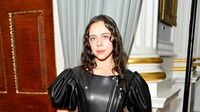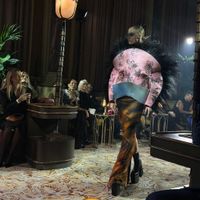London Fashion Week Spring/Summer 2026 has taken the city by storm, unfurling a tapestry of bold statements, emotional tributes, and striking innovation. From the marble-tiled showrooms of Chelsea to the grandeur of the Chancery Rosewood ballroom, designers both established and emerging have seized the moment to redefine British fashion’s direction. With the event officially opened on September 18, 2025, by British Fashion Council CEO Laura Weir, who called for “positive transformation” and a renewed commitment to inclusivity and creativity, this season’s collections have more than risen to the challenge.
Weir’s speech, as reported by Marie Claire, set an ambitious tone: “London Fashion Week represents an entire living economy — from designers and makers to stylists, technicians and beyond — and is one of the UK’s most vital cultural exports.” Her push to remove barriers and welcome new voices resonated throughout the week’s showcases, as designers responded with collections that balanced tradition and experimentation, commercial appeal and high artistry.
One of the most talked-about shows was Emilia Wickstead’s, held in her Chelsea showroom. The presence of ex-Vogue editor-in-chief Anna Wintour in the front row underscored Wickstead’s rising stature within the British fashion calendar. Known for dressing the Princess of Wales in understated yet striking ensembles, Wickstead surprised many this season by trading her signature demure daywear for daring cuts, vivid colors, and sculptural silhouettes. Drawing inspiration from celebrity photographer Robert Mapplethorpe’s muses, the collection explored the theme of subtle power and controlled exposure. A standout piece—a saturated cobalt blue dress with a soft balloon hem and high gathered neckline—captured the season’s penchant for balancing fluidity with structure.
Wickstead’s evolution was evident in the bold neon yellow dress with a drop-peplum skirt and in separates like a pink V-neck sweater paired with a yellow lattice-print skirt. The collection maintained her hallmark formality but reframed it for women seeking both confidence and refinement. As The Independent noted, “Shoulders and backs are exposed but framed; skirts have volume but not weight; colours are intense but used sparingly.” The workmanship shone in details like clean joins of chiffon to seam and the way fabrics moved naturally with the models. Wickstead’s move towards maximalism signaled her readiness to step beyond the “ladylike” niche and into a broader, more contemporary relevance.
Elsewhere, the runways were alive with unforgettable moments and diverse creative visions. Naomi Campbell’s appearance at Richard Quinn’s show was a highlight, as she opened the runway in a black velvet gown with a sculptural white collar and camellia. According to TheIndustry.fashion, the collection featured sweeping ball gowns, velvet cocktail dresses, and off-the-shoulder silhouettes, unified by the ever-present rosette motif. Quinn’s careful use of color—deep blacks and reds giving way to lighter blues and creams—hinted at his growing interest in bridal influences, though these ambitions remained secondary to his signature drama and couture flair.
Roksanda Ilinčić marked a milestone with her twentieth London Fashion Week show, presenting a collection inspired by modernist sculptor Barbara Hepworth. The Chancery Rosewood ballroom provided a fitting backdrop for Roksanda’s sculptural elegance, with silhouettes embracing negative space and textures that invited touch. Painterly prints and architectural tailoring bridged past and future, while her tribute to Hepworth’s legacy was woven through every detail. As TheIndustry.fashion observed, the collection was “an ode to femininity in all its strength, complexity, and grace.”
Harri, known for avant-garde latex creations, took a bold step towards ready-to-wear with his third London Fashion Week collection at the Barbican. Latex, often seen as unyielding and impractical, was transformed into wearable streetwear—brown pleated overcoats, latex jeans, and mesh pieces—channeling what Harri described as the spirit of “London.” The collection remained true to his vision of liberal sensuality and free expression, convincing even the most conservative observers of latex’s streetwear potential.
Marie Lueder’s debut capsule collection with Pull&Bear brought Berlin club aesthetics and medieval tropes to the British Fashion Council’s NEWGEN space. Titled “Convivium,” the show was staged as a Roman feast with models strutting across a literal dinner table. The collection balanced anarchic fun with commercial appeal, featuring oversized sweaters, distressed t-shirts, and a finale look that combined jester-like proportions with sheer layers. The collaboration, supported by the British Fashion Council, maintained Lueder’s signature sense of chaotic yet wearable fashion.
Johanna Parv, drawing on her background as a runner and actor, delivered a collection built for movement and modern life. Her “Action” and “Frame” bags exemplified her utilitarian yet refined aesthetic, designed for adaptability and tested in real-life scenarios. Parv’s garments featured hidden pockets, adjustable components, and secret hoods—details inspired by the book Streetwalking the Metropolis, which examines urban life from a female perspective. Her use of traditional materials and tailoring motifs, reimagined through a contemporary lens, resonated with the week’s emphasis on fluidity and versatility.
Other standout moments included Tove’s partnership with Pandora for minimalist accessories, Kent & Curwen’s springtime vision with bubble-hem skirts and rugby-ball-shaped handbags, and Labrum’s “Osmosis” collection, which fused West African rhythms with UK jazz. Bora Aksu brought the doily dressing trend into SS26 with layers of lace and embroidery inspired by childhood porcelain dolls, while Daniel Fletcher’s second collection for Mithridate drew celebrity attendees like Asa Butterfield and Ellie Bamber to the Royal Opera House front row.
Not to be overlooked, Completed Works founder Anna Jewesbury staged a dramatization starring Jerry Hall, reminding audiences of the emotional resonance of possessions and memories. Patrick McDowell, this year’s British Fashion Council Queen Elizabeth II Award winner, presented a collection inspired by his grandmother, with each guest receiving a digital passport linking to her story—a moving intersection of fashion and personal history.
Pauline Dujancourt’s show at the Strand stood out for its emotional depth, exploring grief and acceptance through garments inspired by Chekhov’s The Seagull. The collection moved from sheer white lace and rose appliqués to somber blacks and fluid blues, symbolizing the non-linear journey of mourning. Dujancourt’s technical mastery and sensitivity were evident in every stitch, culminating in a finale dress that embodied resilience and hope.
With every show, London Fashion Week Spring/Summer 2026 reaffirmed its reputation as a crucible of creativity, where heritage and innovation collide. The energy, diversity, and sheer ambition on display left no doubt: British fashion is not only evolving—it’s thriving, with a new generation of designers ready to shape its future.

